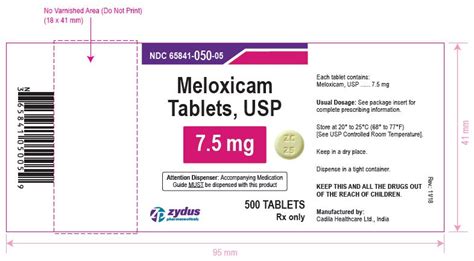Intro
Discover what Meloxicam is, a nonsteroidal anti-inflammatory drug (NSAID) used to treat pain, inflammation, and arthritis, with information on its uses, side effects, and interactions, as a COX-2 inhibitor for osteoarthritis and rheumatoid arthritis relief.
Meloxicam is a type of nonsteroidal anti-inflammatory drug (NSAID) that is commonly used to treat pain, inflammation, and stiffness in conditions such as osteoarthritis, rheumatoid arthritis, and ankylosing spondylitis. It works by blocking the production of prostaglandins, which are chemicals in the body that cause pain and inflammation. By reducing the production of these chemicals, meloxicam helps to alleviate symptoms such as joint pain, swelling, and stiffness, making it easier for people to perform daily activities.
The importance of meloxicam lies in its ability to provide relief from chronic pain and inflammation, which can significantly impact a person's quality of life. For people living with conditions such as arthritis, meloxicam can be a valuable treatment option, helping to manage symptoms and improve mobility. Additionally, meloxicam is often used to treat other conditions, such as tendinitis and bursitis, making it a versatile and widely used medication.
Meloxicam is available in various forms, including tablets, capsules, and injectable solutions, and is typically taken once a day. It is essential to follow the dosage instructions provided by a healthcare professional, as taking too much meloxicam can increase the risk of side effects. Common side effects of meloxicam include stomach upset, nausea, and dizziness, but more severe side effects can occur, such as stomach ulcers and kidney damage. Therefore, it is crucial to discuss the potential risks and benefits of meloxicam with a healthcare professional before starting treatment.
Meloxicam Mechanism of Action

Meloxicam works by inhibiting the production of prostaglandins, which are chemicals in the body that cause pain and inflammation. Prostaglandins are produced by an enzyme called cyclooxygenase (COX), which has two forms: COX-1 and COX-2. COX-1 is involved in maintaining the health of the stomach and intestines, while COX-2 is involved in the production of prostaglandins that cause pain and inflammation. Meloxicam selectively inhibits COX-2, reducing the production of prostaglandins that cause pain and inflammation, while minimizing the impact on COX-1, which reduces the risk of stomach ulcers and other gastrointestinal side effects.
Benefits of Meloxicam
The benefits of meloxicam include its ability to provide relief from chronic pain and inflammation, improve mobility, and reduce the risk of stomach ulcers and other gastrointestinal side effects. Meloxicam is also available in various forms, making it a convenient treatment option for people with different needs and preferences. Additionally, meloxicam has been shown to be effective in reducing the symptoms of ankylosing spondylitis, a condition that causes inflammation and stiffness in the spine.Meloxicam Uses

Meloxicam is used to treat a variety of conditions, including osteoarthritis, rheumatoid arthritis, ankylosing spondylitis, tendinitis, and bursitis. It is also used to treat pain and inflammation caused by other conditions, such as sprains and strains. Meloxicam is often used in combination with other medications, such as physical therapy and lifestyle modifications, to provide comprehensive treatment for chronic pain and inflammation.
Meloxicam Side Effects
Common side effects of meloxicam include stomach upset, nausea, and dizziness. More severe side effects can occur, such as stomach ulcers, kidney damage, and increased risk of heart attack and stroke. It is essential to discuss the potential risks and benefits of meloxicam with a healthcare professional before starting treatment.Meloxicam Dosage

The dosage of meloxicam varies depending on the condition being treated and the individual's response to the medication. The typical dosage of meloxicam is 7.5-15 mg per day, taken once a day. It is essential to follow the dosage instructions provided by a healthcare professional, as taking too much meloxicam can increase the risk of side effects.
Meloxicam Interactions
Meloxicam can interact with other medications, such as blood thinners, diabetes medications, and blood pressure medications. It is essential to discuss the potential interactions with a healthcare professional before starting treatment.Meloxicam Precautions

Meloxicam precautions include avoiding the use of meloxicam in people with a history of stomach ulcers, kidney disease, or heart disease. Meloxicam should also be used with caution in people who are taking other medications that may interact with meloxicam. Additionally, meloxicam should not be used in people who are pregnant or breastfeeding, as it may harm the fetus or baby.
Meloxicam Warnings
Meloxicam warnings include the risk of stomach ulcers, kidney damage, and increased risk of heart attack and stroke. It is essential to discuss the potential risks and benefits of meloxicam with a healthcare professional before starting treatment.Meloxicam Overdose

Meloxicam overdose can occur if too much of the medication is taken. Symptoms of meloxicam overdose include stomach upset, nausea, and dizziness. If an overdose is suspected, it is essential to seek medical attention immediately.
Meloxicam Storage
Meloxicam should be stored at room temperature, away from moisture and light. It is essential to keep meloxicam out of reach of children and pets.Meloxicam Disposal

Meloxicam disposal should be done properly to avoid environmental contamination. It is essential to dispose of meloxicam and its packaging in a responsible manner, such as by taking it to a pharmacy or a hazardous waste collection facility.
Meloxicam FAQs
What is meloxicam used for?
+Meloxicam is used to treat pain, inflammation, and stiffness in conditions such as osteoarthritis, rheumatoid arthritis, and ankylosing spondylitis.
What are the common side effects of meloxicam?
+Common side effects of meloxicam include stomach upset, nausea, and dizziness.
Can meloxicam be used in people with kidney disease?
+Meloxicam should be used with caution in people with kidney disease, as it may worsen kidney function.
In conclusion, meloxicam is a valuable treatment option for people living with chronic pain and inflammation. Its ability to provide relief from symptoms such as joint pain, swelling, and stiffness makes it an essential medication for people with conditions such as osteoarthritis, rheumatoid arthritis, and ankylosing spondylitis. By understanding the benefits, risks, and precautions associated with meloxicam, people can make informed decisions about their treatment and work with their healthcare professionals to develop a comprehensive treatment plan.
We invite you to share your thoughts and experiences with meloxicam in the comments below. If you have any questions or concerns about meloxicam or other medications, please don't hesitate to reach out to us. Additionally, if you found this article informative and helpful, please share it with others who may benefit from this information.
